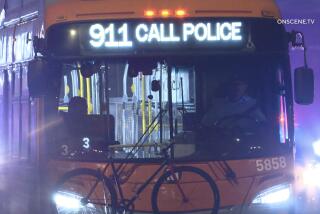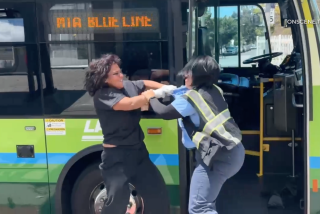Both Sides in Bus Strike Miles Apart : Labor: The union and company are pursuing diverse public strategies. Greyhound chairman does not expect a settlement soon.
- Share via
The two sides in the Greyhound bus strike were hundreds of miles apart Monday, both literally and figuratively, symbolizing the different public strategies they are pursuing in the stalemated, 11-day-old dispute.
The leader of Greyhound’s 9,000 striking workers was in Washington at the request of the director of the Federal Mediation and Conciliation Service, who is trying to rekindle contract negotiations that ended when the strike began.
Greyhound’s chairman, meanwhile, was in Florida, offering a $25,000 reward for information about a sniper attack on a Greyhound bus and pouring cold water on the suggestion that the strike can be settled soon.
Fred G. Currey, chairman of Greyhound Lines Inc.--the man strikers are referring to when they chant “Drop dead Fred”--is taking the hard line. He has expressed little interest in help from a federal mediator, boasts he has accumulated a strike war chest of tens of millions of dollars to absorb a long walkout and claims he will soon make the strikers irrelevant by permanently replacing them with strikebreakers.
The Amalgamated Transit Union, meanwhile, has expressed every willingness to resume negotiations, portraying itself as a victim of “union-busting” and of deep wage cuts it endured in 1983 and 1987 contracts.
Currey, who on Monday boarded a Greyhound bus in Jacksonville, Fla., where a sniper attack injured eight passengers Sunday night, told reporters that Greyhound “will not raise fares to meet the exorbitant demands of the drivers . . . . We will not bend or move because of intimidation and violence.”
James LaSala, president of the Amalgamated Transit Union, spent three hours meeting with Bernard DeLury, director of the federal mediation service, which attempts to bring feuding parties in labor disputes together, although it has no power to compel discussions.
Greyhound last week flatly refused a union request to resume talking, and a Greyhound spokesman said Monday “we’re not certain” if the company would accept an invitation to talk to DeLury. Later in the day, however, the company announced that its chief negotiator, executive vice president P. Anthony Lannie, will meet with DeLury on Wednesday.
Unionized drivers and other workers, who took pay cuts of 7.8% in 1983 and 23% in 1987, are now demanding a four-year contract with a first-year raise estimated by various union officials at between 5% and 10% and annual raises of 5% thereafter. Greyhound says it is offering a first-year increase of 6.9%. Each side characterizes the other’s estimate as wildly inaccurate.
The union is demanding that Greyhound reinstitute pensions for newly hired drivers. It also strongly objects to Greyhound’s proposal to delete the word “reasonable” from a clause limiting the kinds of employee-conduct rules the company can introduce.
While Greyhound said early in the strike that it would restore much of its service by the end of the month using replacement workers, it has so far hired only 1,107, compared to a union force of 6,000 drivers. It is running only 33% of its normal departures. Service in its western division actually dropped over the weekend, to 27% of normal Sunday from 29% Saturday.
At the company’s Los Angeles terminal, long lines of bleary-eyed travelers continue to wait in a line that is still served by only one clerk. On Monday during a noisy demonstration here by 100 drivers and members of other unions, a woman who identified herself as a regular Greyhound rider emerged from the terminal to cheer the strikers on.
Wanda Lipscomb of Los Angeles said she takes a Greyhound bus monthly to the California Correctional Training Facility at Soledad east of Monterey to visit her husband, an inmate. It usually takes six hours but the trip that began Sunday evening took 12 hours, she said.
Lipscomb said that she and other passengers were forced to stand during the trip because Greyhound sold too many seats--a problem the company admits is occurring because of the limited number of buses. She also said that the driver lost his way and had to ask riders for directions.
“It was like a nightmare in there,” Lipscomb said. “They sell people tickets and they don’t have the room.”
Greyhound’s threat to permanently replace strikers with replacement drivers is complicated by the fact that the strike was called on grounds of unfair labor practices, rather than simple economics.
The National Labor Relations Board is currently reviewing a complaint by the union that Greyhound conducted its pre-strike bargaining in bad faith, making contract demands that no union could accept. Federal labor laws say that after a strike ends, strikers must be returned to their jobs and replacement workers terminated if their employer is found to have committed unfair labor practices.
The NLRB general counsel’s office has yet to rule on the union’s complaint and a similar bad-faith complaint filed by Greyhound against the union.
There have been scattered violent incidents since the strike began, including a striker crushed to death by a bus operated by a replacement driver in Redding, Calif., and shots fired at buses in Chicago and Phoenix. A Greyhound bus in Connecticut was hit by sniper fire Monday. No one was injured in the shooting, which occurred on Interstate 84 shortly before 11 a.m. as a New York-to-Boston Greyhound bus headed into Hartford with 19 passengers.
An executive board member of the Jacksonville union local said he did not believe strikers were behind Sunday night’s Florida shooting, in which someone fired a bullet through the front of a Greyhound bus. The passengers were injured by fiberglass and shrapnel.
“As far as I’m concerned, it wasn’t one of our strikers,” Bill Nicholson said. “They’ve been like choirboys.”
More to Read
Inside the business of entertainment
The Wide Shot brings you news, analysis and insights on everything from streaming wars to production — and what it all means for the future.
You may occasionally receive promotional content from the Los Angeles Times.










